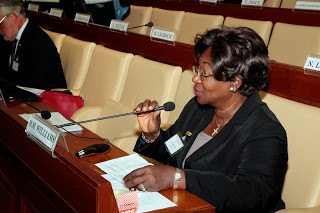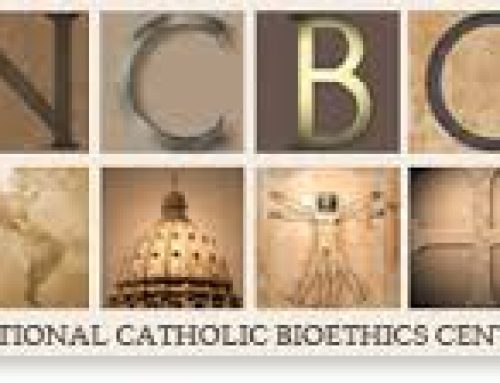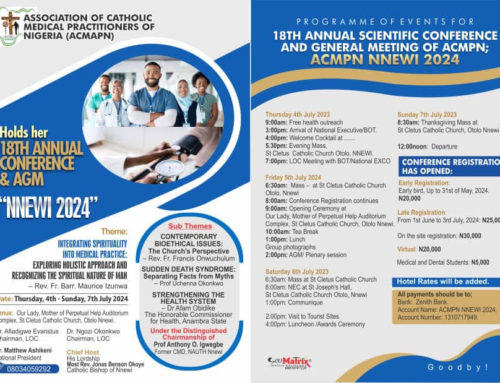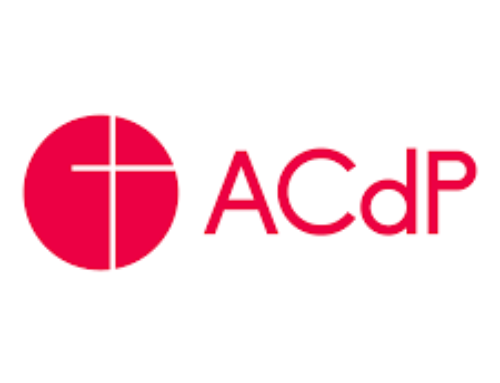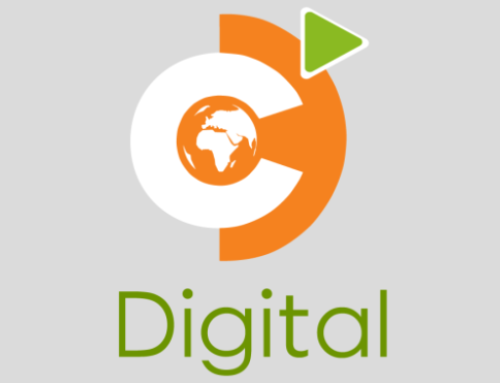A.M.D.G.
THE NEW SLAVERIES: The Sub-Saharan African Situation: Neo Colonisation by the International Agencies
(How Catholics Can Save Civilization)
DR HENRIETTA MARIA WILLIAMS M.D. (Obs/Gyn), FCMC.(Naprotechnology)
National President Association of Catholic Medical Practitioners of Nigeria.
November 2-3 Rome
Introduction
Human trafficking, often qualified as the ‘modern day slavery’, is caused by human rights violations embodied in poverty while it also contributes to increased deprivation. Recent concern about human trafficking in the sub-saharan Africa and attempts to produce a precise definition of human trafficking as an emerging form of human mobility – often labelled as the ‘New Slavery’ – have provoked much controversy owing to the diversity of perspectives from which the subject may be viewed.
According to UNICEF (2003: 9-10) trafficking is recognized as a problem in the greater majority of West African countries and as a severe problem in a third of them. In Eastern and Southern Africa it is also identified as a problem in roughly one in three of the countries.
SITUATION ANALYSIS
West and Central Africa
Veil (1999 in Adepoju, 2005: 77) identifies six different processes that can be involved and may become trafficking:-
Poor parents sell their children for money –having also received promises that they will be treated well.
There is ‘placement’ for a specified period in return for a token sum or gift items.
‘Bonded placement’ of children is the reimbursement for a debt the parents accrued.
There is enrolment with an agent for domestic work – the parents paying the agent a fee.
Fees are also paid agents who purport to enrol the children in some course of schooling or training in a trade but who put them out to domestic work.
And there is straightforward abduction.
ILO-IPEC (2001) offers a detailed picture of the context, patterns and backgrounds of families and communities which have facilitated trafficking in West and Central Africa. It identifies three key clusters of factors, as follows:
(1) socio-cultural factors such as the social acceptability of putting children to work, traditions of migrations that are centuries old in Africa, illiteracy or low education levels, and preparations for marriage (sometimes having to engage in domestic work to pay the
dowry),
(2) economic factors such as the imbalance between rural and urban wealth levels and a desire to escape poverty,
(3) juridical and political factors such as absence of legislation and the ignorance of parents and trafficked persons of their rights under the law, or mistrust of the law; and open borders.
Southern and Eastern Africa
Less information is accessible about the incidence, trends and routes of trafficking of women and children in Southern Africa. Available information suggests that both internal and cross-border forms of trafficking are prevalent.
Molo Songololo (2000) produced an in-depth report on the internal trafficking of children in South Africa for the purposes of commercial sexual exploitation. The findings show children are predominantly trafficked within their country of origin and traffickers are predominantly locals, but that where cross-border movement occurs the traffickers are foreign persons or crime organizations.
Both sexes are exploited although girl children are more likely to be channelled through cross-country migration and lured into the sex industry. Girl children are sold by their family as brides (to single men) or to brothels, syndicates and gangs. They can also be abducted, held captive and sexually assaulted in exchange for money.
Boys tend to be voluntary migrants and engage in homosexual prostitution as a means to survive.
The report provides examples of recruitment of girls into the sex industry through newspapers ads whence ‘young women are then surreptitiously coerced through a form of debt bondage into doing strip-tease work, providing “sex” for patrons of certain establishments or performing in pornographic films’ . A clear link between tourism and the sex trafficking of girls is revealed through interviews with sex
tourists – men actively seeking girl children.
NEO COLONISATION OF SUB-SAHARAN AFRICA BY INTERNATIONAL AGENCIES FOR ECONOMIC GAIN
BACKGROUND TO THE “NEW SLAVERIES” IN THE BIOTECHNOLOGY INDUSTRY
The New Global Ethics
A global post modern cultural revolution with a new global ethics and agenda, under the guise of a “soft consensus” has imposed itself for the purpose of “Integration of global economies.”
The agenda is rooted in Western apostasy and driven by powerful minorities at the rudder of governance since 1989. (”SADDUCES”) represented by UNDP/UNFPA/WHO, World Bank/IMF , and their agencies IPPF, UNAIDS, Marie Stopes, Planned Parenthood, etc.
( Sadducees were a sect or group of Jews within the upper social and economic echelon of Judean society in the Bible in the time of Jesus who did not believe in the Resurrection. The Sadducees had influence on the government of that time).
Today they are `represented` by The Secular Atheistic Humanists, who wish to impose their own ideologies of moral relativism, by force, by blackmail, by threats if necessary on the world ; ideologies which are similar to the ideas of Protagoras’s moral skepticism:
There is no ultimate moral truth
Our individual moral views are equally true
The practical benefit of our moral values is more important than their truth
The practical benefit of moral values is a function of social custom rather than nature
New words, paradigms, norms, values, lifestyles, educational methods and governance processes, belonging to a new ethics, spread globally rules the world cultures.
Majority of intellectuals, politicians, and decision makers follow the new norms without carefully analysing their origin and implication, whilst a minority are reactionary.
As the members of the Church of Christ, obedient to our call of mission, (Matt. 28: 19.) believing in the full authority and power of Christ, and fully standing on the promises of God, we must actively evangelize, resist and oppose this evil by a CULTURAL REVOLUTION OF LOVE.
“New Slaveries” from the Biotechnology Industries:
Trafficking in Human Eggs and Human Embryos
Some Western economies are seeking to transform from electronic technology to the ‘human industry’ using embryonic stem cell research, which if successful, has a potential of raising a $30 Trillion US Dollar market, one-third of World economy for the Bio-tech companies 90% owned by Billionaire members of the Bill and Melinda Gates Foundation, such as The Biotechnology Company Monsanto, St Louis USA and the Danforth Foundation St Louis USA which have huge investments in this industry.
Biotechnology means any technological application that uses biological systems, living organism, or derivatives thereof, to make or modify products or processes for specific use.
Genetically Modified Organism (GMO) means living or non-living organism that possesses a novel, combination of genetic material obtained through the use of modern biotechnology techniques;
Modern biotechnology includes the application of –
in-vitro nucleic acid technique including the use of recombinant deoxyribonucleic acid (DNA) and direct injection of nucleic acid into cells or organelles; or
(b) fusion of cells beyond the taxonomic family, that overcome natural physiological, reproductive and recombination barriers and which are not techniques used in traditional breeding and selection.
Perfection of the key procedure of Somatic Cell Nuclear Transfer (SCNT) that will yield the human organs for the industry requires about 100 million ovarian eggs per annum from at least 10 million women, to make human embryos to be killed and dismembered in these experiments in Western laboratories, in the next five years. The donor women may suffer side effects from complications of ovarian hyper stimulation syndrome (kidney failure, liver failure, cancers, infections etc).
Africans are regarded by the Biotechnology companies as the natural resources for the embryonic stem cell industry, since human egg donation for experimental purposes is banned by law in Western Countries. This new ‘human industry’ will make and sell human organs parts made from embryonic stem cell research.
Many International agencies including UNDP, UNFPA, IPPF, UNICEF, UNDP, WHO, USAID, DFID, CIDA, IMF, World Bank, have been putting pressure on African leaders clouded by naivety and lack of knowledge to pass self-imposed laws by consensus documents which under the guise of sexual and reproductive rights will entrench Sexual and Reproductive Health initiatives, written in foreign countries, running contrary to African cultural and religious faiths and beliefs, to facilitate the biotechnology industries, by surreptitiously slipping into these documents sections that allow the supply of the raw materials needed to export Africans to foreign laboratories as human embryos.
The Sexual and Reproductive Health initiatives contain protocols for abortion and in vitro fertilisation procedures. Abortion is utilised to increase the effectiveness of failed contraception for use in population control by reducing unintended pregnancies, reducing fertility rates, and increasing per capita income in their own index of human development.
These initiatives are FRAUDULENTLY marketed to African countries as aid to improve maternal mortality by reducing unsafe abortion.
ABORTION is an ABOMINATION IN ALL AFRICAN CULTURES and is illegal in all African countries except South Africa whose Maternal Mortality figures have doubled since the abortion law was passed in that country. Their claims for their sexual health initiatives are NOT SUPPORTED by the most recent scientific evidence. The most recent studies from Denmark which have excellent Maternal health records, show very clearly that pregnancy is SAFER than so called `safe abortion`, or therapeutic abortion.
International Protocols and Conventions Used by Western Countries
CEDAW – Convention on Elimination of All Forms of Discrimination about Women
Maputo Protocol – Protocol to the African Charter on Human and People’s Rights on the Rights of Women in Africa .” The Protocol went into effect in November 2005, after the minimum of 15 of the 53 African Union member countries ratified it.
G8 African Action
These protocols are marketed as beneficial to reducing fertility rates of poor Africans thereby increasing their quality of life and their economic empowerment. They are to be domiciled in African countries and ENFORCED BY SEXUAL AND RERODUCTIVE RIGHTS approach, even though they contain articles contradicting the Universal Rights Declaration.
THIS IS NEO-COLONISATION.
Recent well researched studies from John Hopkins School of Public Health show clearly that poverty reduction from reduction of fertility rate is NOT A FUNCTION of sexual and reproductive health initiatives but results from EDUCATION, ECONOMIC STATUS, AND EMPOWERMENT. The authors Recommend parallel investments in programs aimed at poverty eradication (MDG 1), universal primary education (MDG 2), and women’s empowerment (MDG 3).
National Laws Sponsored by Western Countries and International Agencies
New Draft Constitution of the Federal Republic of Nigeria 2013.
National Health Bill 2008, 2012: (Section 51-58), Section 51. (2) No person shall import or export human zygotes or embryos without the prior written approval of the Minister on the recommendation of National Ethics Research Committee. This actually says that ‘Any person can IMPORT or EXPORT HUMAN ZYGOTES OR EMBRYOS with permission of the Minister…
The Association of Catholic Medical Practitioners of Nigeria and other Pro-Life Non Governmental Organisations raised concerns about the serious health risks that current and future egg donations would pose to patients, given our rate of poverty; repeated egg donations for money would cause serious health risks.
This Section 51 should be as follows:
2 (a) No person shall import or export human zygotes or embryos or engage in embryo splitting or killing.
2 (b) All research in reproductive health must be performed with the prior written approval of the Minister on the recommendation of National Ethics Research Committee with the guiding principles of respect for the `Sanctity of Human Life’.
3 (a) the right to life guaranteed by the Constitution is vested in each human being, and is the paramount and most fundamental right of a person; and
(b) the life of each human being begins with fertilization, cloning, or its functional equivalent, irrespective of sex, health, function or disability, defect, stage of biological development, or condition of dependency, at which time every human being shall have all the legal and constitutional attributes and privileges of personhood.
The National Health Bill Sections 52, 53, 54, 55, 56, 57, 58 authorize taking organs (heart, kidney, liver etc), bone marrow and stem cell from living and dead Nigerians for transplantation on order of a doctor or health personnel. There is no CONSENT Clause linking Section 49 with Section 52-58.
This bill should read:- Revised Section 52. (1) A person shall not remove tissue from a living person for transplantation in another living person or carry out the transplantation of such tissue except in accordance with the prescribed conditions of informed consent in Section 49, further including-
(a) in a hospital authorized for that purpose; and
(b) on the written authority of-
(i) the medical practitioner in charge of clinical services in that hospital or any other medical practitioner authorized by him or her; or
(ii) in the case where there is no medical practitioner in charge of the clinical services at that hospital a medical practitioner authorized thereto by the person in charge of the hospital.
(2) The medical practitioner stated in subsection (1)(b) shall not be the lead participant in a transplant for which he has granted authorization under that subsection.
Genetically Modified Organisms and Biosafety Bills sponsored by foreign interests
BILLS engineered to facilitate human embryo trafficking in Nigeria.
An act to provide a framework for the regulation, development and management of a National Health System and Set Standards for Rendering Health Services in the Federation, and other matters connected therewith, 2012 by Ndudi Elumelu and Senator Ifeanyi Okowa
An Act to Regulate Activities in Genetically Modified Organisms, to Establish the National Biosafety Authority and Connected Purposes. (Sections 17-20) By Senator Grace Folashade Bent.
An Act to Establish the Nigerian Assisted Reproduction Authority to among others regulate the Practice of Assisted Reproduction Techniques in Nigeria and Related Matters. By Hon. Kigbu Joseph Haruna
Bills on Concessioning of Public Hospitals to Private Foreign Based Investors. To create Organ Trafficking Centers in Africa.
Bill Gates aims in just a few years to gain the monopoly of staple food crop seeds in the whole of Africa, and hence all of Africa’s food security will be vested in his companies. It is easy to imagine ‘an ovarian egg for food program’ for Nigerians to eat their daily bread.
KEY FACTORS IN HUMAN TRAFFICKING
The fact that trafficking is a very sensitive issue may contribute to public reluctance to acknowledge its prevalence and this itself can be an obstacle to research and data analysis There is tension between two key sets of concerns:
the sovereignty and interests of nation-states as discrete units in international relations; and
the violations of the human rights of persons in a particular process of migration labelled ‘human trafficking’.
In other words, poverty is one of the main factors leading people, especially women and children to fall preys to the traffickers. In turn, human trafficking locks up the trafficked persons in poverty through exploitation. This vicious circle ‘poverty – human trafficking – poverty’ denies individuals the basic right to education and information, the right to health, the right to decent work, the right to security and justice. This is what the person needs together with moral formation for AUTHENTIC HUMAN DEVELOPMENT.
The struggle against human trafficking requires a different approach from that of trafficked goods – such as drugs and small arms despite the similar aspects of illicitness.
Unlike with illicit goods, human trafficking involves a process of exploitation – from debt dependency to enslavement – to ensure continued income from the same trafficked persons. Traffickers objectify persons under their control, put them at work without payment, subject them to repeated sale, and may force them to take deadly options to destroy evidence – or murder them (Truong, 1998, 2003a).
Governments and those civic organisations, which seek to free trafficked persons from enslavement or servitude, and to prosecute traffickers, must deal with people who have been placed in such difficult situations that their perception may have been transformed, and their survival mechanisms manipulated in ways that strengthen rather than reduce dependency.
Current efforts to counteract human trafficking fall into three categories:-
(a) prevention and deterrence,
(b) law enforcement and prosecution of traffickers,
(c) protection of trafficked persons, ‘rehabilitation’ and assistance in social reintegration.
Political and Legal Framework
The diversity of forms of trafficking – particularly those with transnational links – tends to defy the authority of current theories pertaining to migration and their affiliated analytical tools.
Since 1996 West and Central African governments, individually and collectively, have made
significant efforts to reform the judiciary to address human trafficking.
CHILD TRAFFICKING
The Libreville Common Platform of Action of the Sub-regional Consultation of the Development of Strategies to Fight Child Trafficking for Exploitative Labour Purposes in West and Central Africa was signed in 2000 by 21 countries in West and Central Africa (supported by UNICEF and ILO with the cooperation of the government of Gabon).
This was followed by the Declaration of Action Against Trafficking adopted by the Economic Community of West African States (ECOWAS)56 and the endorsement of ECOWAS Plan of Action57 in Dakar in 2001 by 15 member-states.
This Common Platform of Action identifies the main characteristics and causes of child trafficking, and suggests government commitment in several areas:
advocacy and sensitisation campaigns;
setting up appropriate legal and institutional mechanisms to address child trafficking;
improving care received by trafficked children;
monitoring the incidence of trafficking by collating data from (new) research;
improving inter-governmental and inter-ministerial cooperation.
SEX TRAFFICKING
There are currently six perspectives on sex trafficking and related actions:
• A moral problem that leads to intervention for the abolition or prohibition of prostitution or commercial sex;
• A problem of organised crime that leads to legislative reforms, policing and the penalising of criminal networks;
• A migration problem that leads to border controls (passport and identification papers);
• A public order problem that leads to awareness campaigns, publicity about risks, and changing cultural practices;
• A labour problem that leads to intervention such as improving working conditions and labour monitoring systems, and abolishing child labour;
• A human rights problem and a gender issue that lead to intervention to address violence against women and children (Wijers and Lap Chew, 1997).
HUMAN RIGHTS
The human rights theme is the central concern of all epistemic communities working on human trafficking. Two frames for human rights issues can be discerned.
One uses the definition of human trafficking by the Trafficking Protocol for trafficked persons, and
the other follows the lines of socioeconomic rights – taking the identification of poverty, gender, vulnerability and ethnic identity as causal factors.
Among the other actors fighting human trafficking are national governments,
the Office of the High Commissioner for Human Rights (OHCHR), Organisation
for Security and Cooperation in Europe (OSCE), United Nations Development
Programme (UNDP), United Nations Interregional Crime and Justice Research
Institute (UNICRI), United Nations Development Fund for Women (UNIFEM), and
the United Nations High Commissioner for Refugees (UNHCR).
Discussions on human rights protection must therefore be grounded in the specific setting of social transformation and any dialogue on the different possible directions guided by the principle of inclusion and justice for all.
POVERTY REDUCTION SCHEMES
Poverty and wellbeing is defined as the possession of commodities.
A UNICEF report (2002:15) notes: ‘[t]here is a need for prevention approaches that go beyond awareness raising to focus on development.
There are, for example, no poverty reduction schemes to combat child trafficking in the African sub-region other than micro credit schemes in Cameroon and Togo. The costs of awareness-raising activities may be lower than the costs of programmes for poverty reduction. They may be easier to manage and have an immediate impact, while poverty reduction schemes need long-term commitment and maintenance.
However, the absence of systematic poverty eradication strategies and the lack of sustained efforts within prevention activities undermine the impact of the entire prevention arsenal.’ Although poverty is consistently cited as a root cause at the level of policy rhetoric, it is not consistently addressed at the grassroots levels, where income generation activities (IGA) and micro-credit is not always available.
Progress made in the analysis of poverty during the last two decades is a result of close monitoring of the impact of Structural Adjustment Programmes(SAP) on the poor. SAPs consist of a complex bundle of instruments with differing goals although the main aim is to stimulate national economic growth by restoring balance between (1) government revenues and spending, (2) savings and investments, (3) export and import of goods and services, (4) the flow of foreign capital. More than 150 countries have implemented such programmes since the early 1980s. The basic overall goal has been to create a level playing field for different economic actors in the process of global economic integration.
The World Bank is the main architect of Structural Adjustment Programs. It is supported by institutions such as the International Monetary Fund whose main role is to assist with the design of adjustment policies to achieve a viable balance of payment and price stability, and to provide finance to these programmes. The main assumption behind a SAP is that a period of economic austerity is necessary for achieving long-term gains from trade, rising income its conceptual proximity to money and markets.
One major breakthrough achieved by the critique of adjustment policies regards their quantitative approach which uses the monetary measures of income and purchasing power as criteria for drawing what are called ‘poverty lines’ – by which to assess the correlation between economic growth and the level of persistent poverty.
The first point is that this approach fails to capture the multi-dimensional character of poverty as a lived reality.
The Second point is that it raises doubt about its ability to take into account the significance of non-monetary resources used by the poor in response to stress. These resources may include a variety of support networks – such as clan and kinship, civic organisations, community and state – which have all helped cushion adjustment burdens (Elson, 1991; Beneria and Fieldman, 1992). A weakening or disbandment of any of these networks can trigger a downward spiral from relative to chronic poverty levels and poverty reduction.
Mahbub ul Haq et al made significant contributions towards shifting the refocus on poverty and wellbeing away from the possession of commodities.. Their common point of departure is the treatment of human development as an end in itself rather than a means to some other goals.
The Human Development Index (HDI) is a composite statistic of life expectancy, education, and income indices used to rank countries into four tiers of human development. It was created by the Pakistani economist Mahbub ul Haq and the Indian economist Amartya Sen in 1990 and was published by the United Nations Development Programme.[
Central to their framework – better known as the capabilities approach – is the proposition that the absence of entitlements and rights puts a limit on action taken to achieve a meaningful life. They bring to the fore issues of democracy and point to a causal link between a lack of openings for people’s capabilities – resulting from an unjust social system – and the prevalence of poverty among particular social groups.
The emphasis on capabilities provides the scope by which to analyze poverty beyond the level income and to cover. The factors behind government accountability for widespread poverty become visible, point that has been obscured in the ascendancy of neo-liberalism.
The emphasis on capabilities provides the scope by which to analyze poverty beyond the level income and to cover its social and political dimensions – including the structural determinants for individual and collective functioning and achievement.
By placing measures of human development in the matrix representing issues of governance, the capabilities approach allows quantification of poverty conditions of specific social groups. It also gives more credence to the rules of entitlements and rights that affect women, children, the elderly and any marginalized ethnic groups. The factors behind government accountability for widespread poverty become visible, point that has been obscured in the ascendancy of neo-liberalism.
White et al (2003:380) note that the current development literature on poverty emphasizes its multidimensional character and stresses the significance of access to basic services. At the macro-level the aggregate outcome of positive child development contributes to a country’s present and future overall development. The growing body of literature on child poverty also emphasizes the capabilities of families and societies to nurture, guide and protect children – which is a basic thread in the social fabric and relies on ‘a network of family and community relationships and support systems that underpins livelihoods and human welfare’ (Harper and Marcus, 2000: 66). An adequate understanding of the mechanisms of intergenerational poverty transfer is much needed to address its long-term entrenchment in society.
Since 1990, the UNDP through its Human Development Reports has promoted a concept of poverty that encompasses ‘security’ in daily life and ‘empowerment’ as human agency – concepts predicated on the notion of control over one’s destiny through voice and political choice.
Since the World Development Report of 2000–2001 the World Bank has also embraced the notion of empowerment by introducing a participatory approach to poverty assessment. Because individual and community responses to crisis are mixed, the various ways in which local institutions are or are not able to support individuals and communities in handling and managing external shocks have become an important area of inquiry for comparison and learning. (Christiaensen et al 2003).
Conclusions
There is a need for a total change in our culture from secularity and neo liberalism to Gospel Values.
Secularity feeds 4 problems that cripple us as a society.:-
1. The global secular culture is built on marketing, which appeals to desire and emotion, suppressing critical thought. We need a political system that depends for its success on a literate, reasoning population grounded in moral values. WISDOM.
2. The global secular culture fails to remember history because the past is full of memories of mistakes and unkept promises. We need to remember the lessons of the past, and not reinvent the wheel.
3. We need imagination and hope to know about things we cannot measure, and that we are not a collection of intelligent carbon atoms, otherwise science and technology carry with them a “revenge of unintended consequences”, so we become its objects and victims. Science and technology should be at the service of the human person, not the person at the service of science culminating in a rise in the materialistic view of the world and a collapse in our confidence that humanity is unique and sacred in creation. We need to talk about THE SANCTITY OF THE HUMAN PERSON, UNDERSTAND HUMAN DIGNITY when we talk about HUMAN RIGHTS.
4. WE must recognise and live REAL HUMAN FREEDOM, which is not just a supply of options and choices which is only another form of idolatry, held together by the economy we share and money as a glue for everything which is a commodity to be bought and sold. Freedom is the ability to see and the courage to do WHAT IS MORALLY RIGHT. This is the culture we must change in a “ New Evangelisation.”
Recommendations
WE NEED TO INITIATE A COUNTER CULTURAL REVOLUTION OF LOVE
The social teachings of the Catholic Church on justice and peace address the shortcomings of the contemporary secular culture. The Natural Law of God requires that we “act justly, love tenderly, and walk humbly with your God.” Mic 6: 6,8.) .
1. We need to actively promote SOCIO-CULTURAL- EDUCATION grounded in EVANGELISATION in the Christian Culture which recognises the Dignity of the Human Person created in the Image of God as the end of Human Development according to the natural law of the Creator God.
2. There must be a paradigm Shift from the relativism of Moral Scepticism to recognising and accepting the wisdom of objective truth.
3. The Moral element is important in Economic Empowerment.
4. We must put into place a JURIDICIAL Reorientation from a Rights Approach to a Personhood Approach in implementing global initiatives for improvements in the quality of life of human persons.
——————————————————————-

